Stephanie Schuckers
A Comparative Evaluation of Deep Learning Models for Speech Enhancement in Real-World Noisy Environments
Jun 17, 2025Abstract:Speech enhancement, particularly denoising, is vital in improving the intelligibility and quality of speech signals for real-world applications, especially in noisy environments. While prior research has introduced various deep learning models for this purpose, many struggle to balance noise suppression, perceptual quality, and speaker-specific feature preservation, leaving a critical research gap in their comparative performance evaluation. This study benchmarks three state-of-the-art models Wave-U-Net, CMGAN, and U-Net, on diverse datasets such as SpEAR, VPQAD, and Clarkson datasets. These models were chosen due to their relevance in the literature and code accessibility. The evaluation reveals that U-Net achieves high noise suppression with SNR improvements of +71.96% on SpEAR, +64.83% on VPQAD, and +364.2% on the Clarkson dataset. CMGAN outperforms in perceptual quality, attaining the highest PESQ scores of 4.04 on SpEAR and 1.46 on VPQAD, making it well-suited for applications prioritizing natural and intelligible speech. Wave-U-Net balances these attributes with improvements in speaker-specific feature retention, evidenced by VeriSpeak score gains of +10.84% on SpEAR and +27.38% on VPQAD. This research indicates how advanced methods can optimize trade-offs between noise suppression, perceptual quality, and speaker recognition. The findings may contribute to advancing voice biometrics, forensic audio analysis, telecommunication, and speaker verification in challenging acoustic conditions.
OcularAge: A Comparative Study of Iris and Periocular Images for Pediatric Age Estimation
May 08, 2025


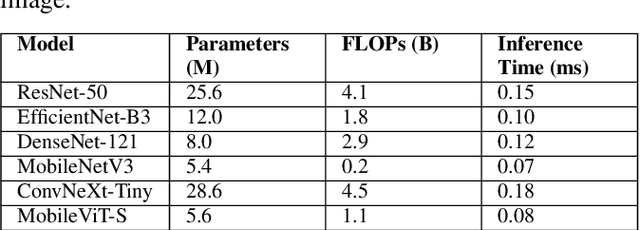
Abstract:Estimating a child's age from ocular biometric images is challenging due to subtle physiological changes and the limited availability of longitudinal datasets. Although most biometric age estimation studies have focused on facial features and adult subjects, pediatric-specific analysis, particularly of the iris and periocular regions, remains relatively unexplored. This study presents a comparative evaluation of iris and periocular images for estimating the ages of children aged between 4 and 16 years. We utilized a longitudinal dataset comprising more than 21,000 near-infrared (NIR) images, collected from 288 pediatric subjects over eight years using two different imaging sensors. A multi-task deep learning framework was employed to jointly perform age prediction and age-group classification, enabling a systematic exploration of how different convolutional neural network (CNN) architectures, particularly those adapted for non-square ocular inputs, capture the complex variability inherent in pediatric eye images. The results show that periocular models consistently outperform iris-based models, achieving a mean absolute error (MAE) of 1.33 years and an age-group classification accuracy of 83.82%. These results mark the first demonstration that reliable age estimation is feasible from children's ocular images, enabling privacy-preserving age checks in child-centric applications. This work establishes the first longitudinal benchmark for pediatric ocular age estimation, providing a foundation for designing robust, child-focused biometric systems. The developed models proved resilient across different imaging sensors, confirming their potential for real-world deployment. They also achieved inference speeds of less than 10 milliseconds per image on resource-constrained VR headsets, demonstrating their suitability for real-time applications.
Smartphone-based Iris Recognition through High-Quality Visible Spectrum Iris Capture
Dec 17, 2024Abstract:Iris recognition is widely acknowledged for its exceptional accuracy in biometric authentication, traditionally relying on near-infrared (NIR) imaging. Recently, visible spectrum (VIS) imaging via accessible smartphone cameras has been explored for biometric capture. However, a thorough study of iris recognition using smartphone-captured 'High-Quality' VIS images and cross-spectral matching with previously enrolled NIR images has not been conducted. The primary challenge lies in capturing high-quality biometrics, a known limitation of smartphone cameras. This study introduces a novel Android application designed to consistently capture high-quality VIS iris images through automated focus and zoom adjustments. The application integrates a YOLOv3-tiny model for precise eye and iris detection and a lightweight Ghost-Attention U-Net (G-ATTU-Net) for segmentation, while adhering to ISO/IEC 29794-6 standards for image quality. The approach was validated using smartphone-captured VIS and NIR iris images from 47 subjects, achieving a True Acceptance Rate (TAR) of 96.57% for VIS images and 97.95% for NIR images, with consistent performance across various capture distances and iris colors. This robust solution is expected to significantly advance the field of iris biometrics, with important implications for enhancing smartphone security.
Post-Mortem Human Iris Segmentation Analysis with Deep Learning
Aug 06, 2024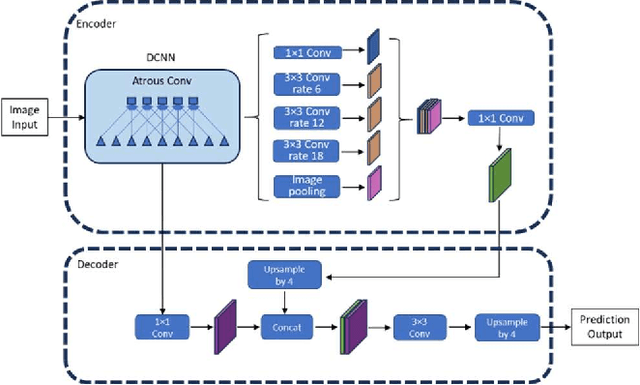
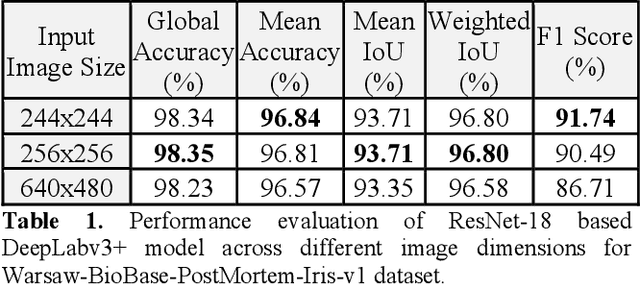
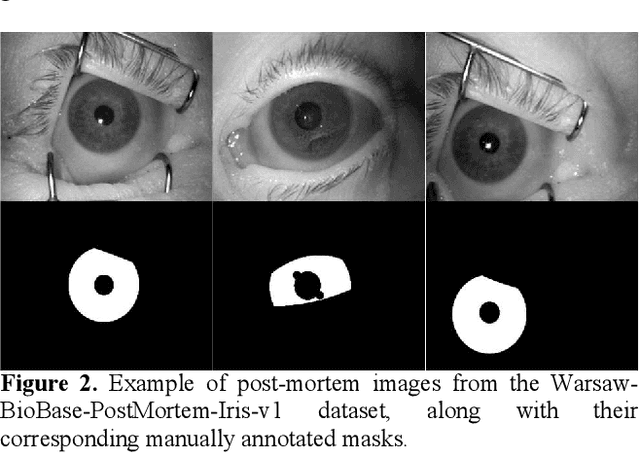
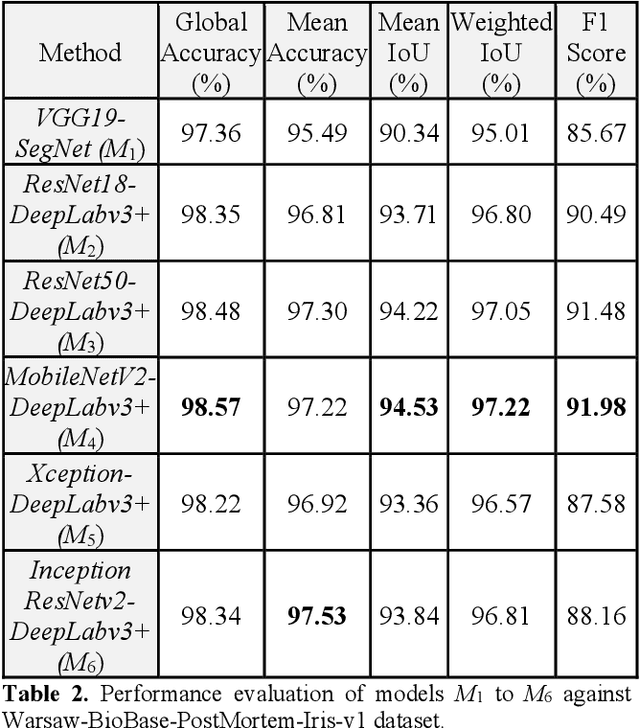
Abstract:Iris recognition is widely used in several fields such as mobile phones, financial transactions, identification cards, airport security, international border control, voter registration for living persons. However, the possibility of identifying deceased individuals based on their iris patterns has emerged recently as a supplementary or alternative method valuable in forensic analysis. Simultaneously, it poses numerous new technological challenges and one of the most challenging among them is the image segmentation stage as conventional iris recognition approaches have struggled to reliably execute it. This paper presents and compares Deep Learning (DL) models designed for segmenting iris images collected from the deceased subjects, by training SegNet and DeepLabV3+ semantic segmentation methods where using VGG19, ResNet18, ResNet50, MobileNetv2, Xception, or InceptionResNetv2 as backbones. In this study, our experiments demonstrate that our proposed method effectively learns and identifies specific deformations inherent in post-mortem samples and providing a significant improvement in accuracy. By employing our novel method MobileNetv2 as the backbone of DeepLabV3+ and replacing the final layer with a hybrid loss function combining Boundary and Dice loss, we achieve Mean Intersection over Union of 95.54% on the Warsaw-BioBase-PostMortem-Iris-v1 dataset. To the best of our knowledge, this study provides the most extensive evaluation of DL models for post-mortem iris segmentation.
Deep Learning Approach for Ear Recognition and Longitudinal Evaluation in Children
Aug 02, 2024



Abstract:Ear recognition as a biometric modality is becoming increasingly popular, with promising broader application areas. While current applications involve adults, one of the challenges in ear recognition for children is the rapid structural changes in the ear as they age. This work introduces a foundational longitudinal dataset collected from children aged 4 to 14 years over a 2.5-year period and evaluates ear recognition performance in this demographic. We present a deep learning based approach for ear recognition, using an ensemble of VGG16 and MobileNet, focusing on both adult and child datasets, with an emphasis on longitudinal evaluation for children.
Longitudinal Evaluation of Child Face Recognition and the Impact of Underlying Age
Aug 01, 2024
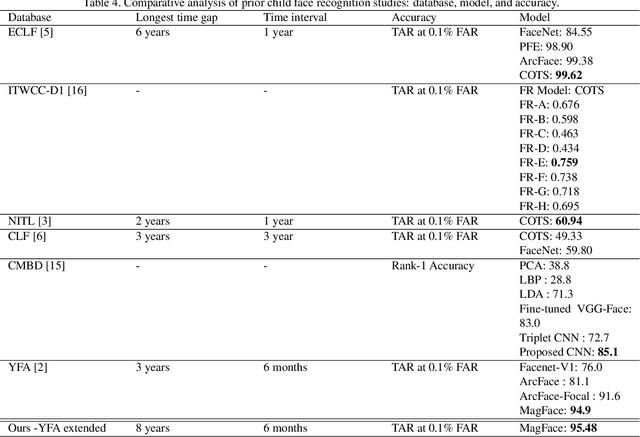
Abstract:The need for reliable identification of children in various emerging applications has sparked interest in leveraging child face recognition technology. This study introduces a longitudinal approach to enrollment and verification accuracy for child face recognition, focusing on the YFA database collected by Clarkson University CITeR research group over an 8 year period, at 6 month intervals.
Iris Liveness Detection Competition (LivDet-Iris) -- The 2023 Edition
Oct 06, 2023



Abstract:This paper describes the results of the 2023 edition of the ''LivDet'' series of iris presentation attack detection (PAD) competitions. New elements in this fifth competition include (1) GAN-generated iris images as a category of presentation attack instruments (PAI), and (2) an evaluation of human accuracy at detecting PAI as a reference benchmark. Clarkson University and the University of Notre Dame contributed image datasets for the competition, composed of samples representing seven different PAI categories, as well as baseline PAD algorithms. Fraunhofer IGD, Beijing University of Civil Engineering and Architecture, and Hochschule Darmstadt contributed results for a total of eight PAD algorithms to the competition. Accuracy results are analyzed by different PAI types, and compared to human accuracy. Overall, the Fraunhofer IGD algorithm, using an attention-based pixel-wise binary supervision network, showed the best-weighted accuracy results (average classification error rate of 37.31%), while the Beijing University of Civil Engineering and Architecture's algorithm won when equal weights for each PAI were given (average classification rate of 22.15%). These results suggest that iris PAD is still a challenging problem.
Liveness Detection Competition -- Noncontact-based Fingerprint Algorithms and Systems (LivDet-2023 Noncontact Fingerprint)
Oct 01, 2023


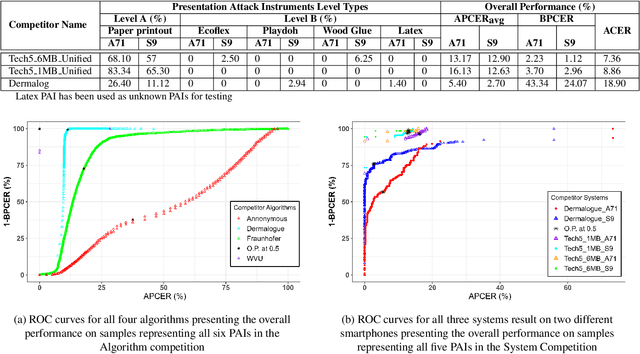
Abstract:Liveness Detection (LivDet) is an international competition series open to academia and industry with the objec-tive to assess and report state-of-the-art in Presentation Attack Detection (PAD). LivDet-2023 Noncontact Fingerprint is the first edition of the noncontact fingerprint-based PAD competition for algorithms and systems. The competition serves as an important benchmark in noncontact-based fingerprint PAD, offering (a) independent assessment of the state-of-the-art in noncontact-based fingerprint PAD for algorithms and systems, and (b) common evaluation protocol, which includes finger photos of a variety of Presentation Attack Instruments (PAIs) and live fingers to the biometric research community (c) provides standard algorithm and system evaluation protocols, along with the comparative analysis of state-of-the-art algorithms from academia and industry with both old and new android smartphones. The winning algorithm achieved an APCER of 11.35% averaged overall PAIs and a BPCER of 0.62%. The winning system achieved an APCER of 13.0.4%, averaged over all PAIs tested over all the smartphones, and a BPCER of 1.68% over all smartphones tested. Four-finger systems that make individual finger-based PAD decisions were also tested. The dataset used for competition will be available 1 to all researchers as per data share protocol
Generalizability and Application of the Skin Reflectance Estimate Based on Dichromatic Separation (SREDS)
Sep 03, 2023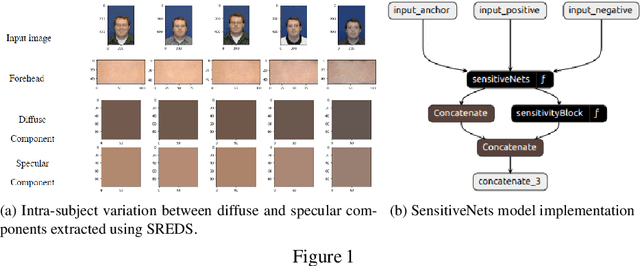
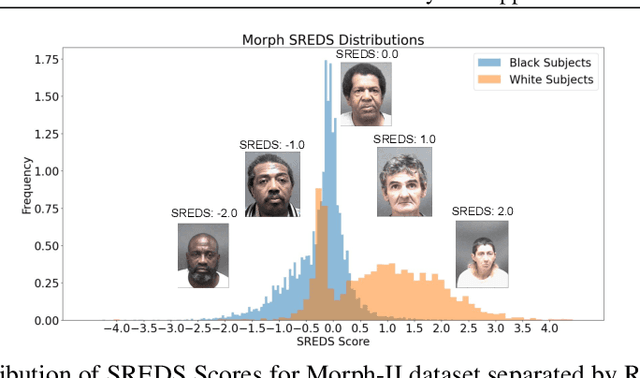

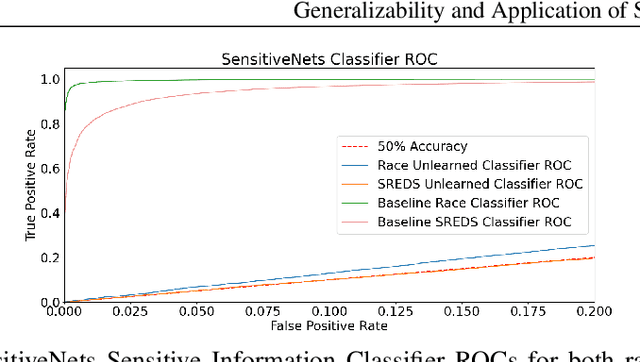
Abstract:Face recognition (FR) systems have become widely used and readily available in recent history. However, differential performance between certain demographics has been identified within popular FR models. Skin tone differences between demographics can be one of the factors contributing to the differential performance observed in face recognition models. Skin tone metrics provide an alternative to self-reported race labels when such labels are lacking or completely not available e.g. large-scale face recognition datasets. In this work, we provide a further analysis of the generalizability of the Skin Reflectance Estimate based on Dichromatic Separation (SREDS) against other skin tone metrics and provide a use case for substituting race labels for SREDS scores in a privacy-preserving learning solution. Our findings suggest that SREDS consistently creates a skin tone metric with lower variability within each subject and SREDS values can be utilized as an alternative to the self-reported race labels at minimal drop in performance. Finally, we provide a publicly available and open-source implementation of SREDS to help the research community. Available at https://github.com/JosephDrahos/SREDS
Uniqueness of Iris Pattern Based on AR Model
Jun 21, 2023Abstract:The assessment of iris uniqueness plays a crucial role in analyzing the capabilities and limitations of iris recognition systems. Among the various methodologies proposed, Daugman's approach to iris uniqueness stands out as one of the most widely accepted. According to Daugman, uniqueness refers to the iris recognition system's ability to enroll an increasing number of classes while maintaining a near-zero probability of collision between new and enrolled classes. Daugman's approach involves creating distinct IrisCode templates for each iris class within the system and evaluating the sustainable population under a fixed Hamming distance between codewords. In our previous work [23], we utilized Rate-Distortion Theory (as it pertains to the limits of error-correction codes) to establish boundaries for the maximum possible population of iris classes supported by Daugman's IrisCode, given the constraint of a fixed Hamming distance between codewords. Building upon that research, we propose a novel methodology to evaluate the scalability of an iris recognition system, while also measuring iris quality. We achieve this by employing a sphere-packing bound for Gaussian codewords and adopting a approach similar to Daugman's, which utilizes relative entropy as a distance measure between iris classes. To demonstrate the efficacy of our methodology, we illustrate its application on two small datasets of iris images. We determine the sustainable maximum population for each dataset based on the quality of the images. By providing these illustrations, we aim to assist researchers in comprehending the limitations inherent in their recognition systems, depending on the quality of their iris databases.
 Add to Chrome
Add to Chrome Add to Firefox
Add to Firefox Add to Edge
Add to Edge